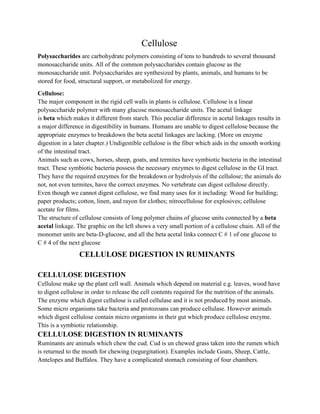Report
Share

Recommended
Recommended
More Related Content
Similar to CELLULOSE_DIGESTION_.docx
Similar to CELLULOSE_DIGESTION_.docx (20)
After reading the text, please describe the 3 types of chemical bond.docx

After reading the text, please describe the 3 types of chemical bond.docx
More from MidhatSarfraz
More from MidhatSarfraz (20)
Recently uploaded
Xanthomonas axonopodis pv.citri is a bacterium that attacks citrus trees and flourishes in locations with high temperatures, rains and strong winds. In places with these features, X. axonopodis pv.citri produces citrus canker, resulting in significant economic losses for citrus companies. It spreads by the unintentional movement of diseased citrus fruits and seedlings to uninfected areas.Virulence Analysis of Citrus canker caused by Xanthomonas axonopodis pv. citr...

Virulence Analysis of Citrus canker caused by Xanthomonas axonopodis pv. citr...TALAPATI ARUNA CHENNA VYDYANAD
Recently uploaded (20)
PLANT DISEASE MANAGEMENT PRINCIPLES AND ITS IMPORTANCE

PLANT DISEASE MANAGEMENT PRINCIPLES AND ITS IMPORTANCE
Virulence Analysis of Citrus canker caused by Xanthomonas axonopodis pv. citr...

Virulence Analysis of Citrus canker caused by Xanthomonas axonopodis pv. citr...
Mining Activity and Investment Opportunity in Myanmar.pptx

Mining Activity and Investment Opportunity in Myanmar.pptx
ERTHROPOIESIS: Dr. E. Muralinath & R. Gnana Lahari

ERTHROPOIESIS: Dr. E. Muralinath & R. Gnana Lahari
Exomoons & Exorings with the Habitable Worlds Observatory I: On the Detection...

Exomoons & Exorings with the Habitable Worlds Observatory I: On the Detection...
Constraints on Neutrino Natal Kicks from Black-Hole Binary VFTS 243

Constraints on Neutrino Natal Kicks from Black-Hole Binary VFTS 243
Emergent ribozyme behaviors in oxychlorine brines indicate a unique niche for...

Emergent ribozyme behaviors in oxychlorine brines indicate a unique niche for...
Jet reorientation in central galaxies of clusters and groups: insights from V...

Jet reorientation in central galaxies of clusters and groups: insights from V...
Quantifying Artificial Intelligence and What Comes Next!

Quantifying Artificial Intelligence and What Comes Next!
GBSN - Microbiology (Unit 7) Microbiology in Everyday Life

GBSN - Microbiology (Unit 7) Microbiology in Everyday Life
Manganese‐RichSandstonesasanIndicatorofAncientOxic LakeWaterConditionsinGale...

Manganese‐RichSandstonesasanIndicatorofAncientOxic LakeWaterConditionsinGale...
CELLULOSE_DIGESTION_.docx
- 1. Cellulose Polysaccharides are carbohydrate polymers consisting of tens to hundreds to several thousand monosaccharide units. All of the common polysaccharides contain glucose as the monosaccharide unit. Polysaccharides are synthesized by plants, animals, and humans to be stored for food, structural support, or metabolized for energy. Cellulose: The major component in the rigid cell walls in plants is cellulose. Cellulose is a linear polysaccharide polymer with many glucose monosaccharide units. The acetal linkage is beta which makes it different from starch. This peculiar difference in acetal linkages results in a major difference in digestibility in humans. Humans are unable to digest cellulose because the appropriate enzymes to breakdown the beta acetal linkages are lacking. (More on enzyme digestion in a later chapter.) Undigestible cellulose is the fiber which aids in the smooth working of the intestinal tract. Animals such as cows, horses, sheep, goats, and termites have symbiotic bacteria in the intestinal tract. These symbiotic bacteria possess the necessary enzymes to digest cellulose in the GI tract. They have the required enzymes for the breakdown or hydrolysis of the cellulose; the animals do not, not even termites, have the correct enzymes. No vertebrate can digest cellulose directly. Even though we cannot digest cellulose, we find many uses for it including: Wood for building; paper products; cotton, linen, and rayon for clothes; nitrocellulose for explosives; cellulose acetate for films. The structure of cellulose consists of long polymer chains of glucose units connected by a beta acetal linkage. The graphic on the left shows a very small portion of a cellulose chain. All of the monomer units are beta-D-glucose, and all the beta acetal links connect C # 1 of one glucose to C # 4 of the next glucose CELLULOSE DIGESTION IN RUMINANTS CELLULOSE DIGESTION Cellulose make up the plant cell wall. Animals which depend on material e.g. leaves, wood have to digest cellulose in order to release the cell contents required for the nutrition of the animals. The enzyme which digest cellulose is called cellulase and it is not produced by most animals. Some micro organisms take bacteria and protozoans can produce cellulase. However animals which digest cellulose contain micro organisms in their gut which produce cellulose enzyme. This is a symbiotic relationship. CELLULOSE DIGESTION IN RUMINANTS Ruminants are animals which chew the cud. Cud is un chewed grass taken into the rumen which is returned to the mouth for chewing (regurgitation). Examples include Goats, Sheep, Cattle, Antelopes and Buffalos. They have a complicated stomach consisting of four chambers.
- 2. Mouth. There is no enzyme secretion in the mouth so only mastication and Softening of food occurs. Movement of food in the oesophagus is by Peristalsis. Rumen. This is the largest component of the stomach where food is stored temporarily before returning to the mouth for chewing. The food is return to the mouth by anti peristalsis. The ruminant then lies down quietly and chews the cud. When the food is sufficiently chewed it is swallowed and passed into the reticulum. Reticulum. Bacteria action continues. It also separates finely ground material from course ones and then retains and hard pieces of wood. Omasum. Consists of parallel leaf like compartments with rough surfaces. The food is ground finely. Absorption of water takes place at this region Abomasum. Also called the true stomach. Enzymatic action of proteins takes place here. Beyond this point digestion takes place like in man. Other animals like termites eat wood, dry leaves etc which also contain cellulose. The digestion of cellulose in termites is also done by cellulase enzyme produced by protozoans which live symbiotically with the termites. The products of cellulose digestion may be glucose or acetic acid in other animals.